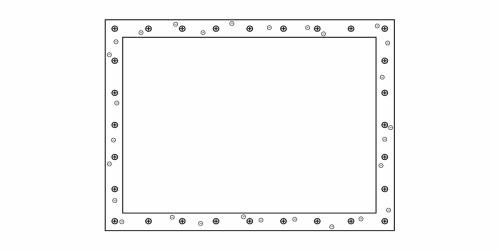
A Faraday cage is a box or cage-like structure made of electrically conductive material, such as copper or iron, that prevents static electric fields from penetrating inside the cage. The Faraday cage is named after its inventor, the scientist Michael Faraday.
The cage is permeable to static magnetic fields, such as the Earth's magnetic and external electric fields. For this reason, the Faraday cage protects from static electrical discharges such as lightning in a thunderstorm.
The term 'Faraday cage' is used today mainly for rooms that exclude electromagnetic waves. These spaces become dead spaces without electromagnetic fields.
Today, Faraday cages are used in various settings, from homes and office buildings to automobiles and aircraft. They are also used in medical devices such as MRI machines and pacemakers, as well as in electronics laboratories, to isolate sensitive equipment from outside interference.
Who invented the Faraday cage?
The English physicist Michael Faraday invented the Faraday cage in 1836. He discovered that if a metal container is filled with an electrically conductive material such as metal foil or wire mesh, it will shield anything inside it from electric fields. This discovery led to the development of electrical enclosures that could protect equipment from damaging electrical surges.
The physicist noticed that the electric charge on a conductor only exists outside the conductor without any influence on anything inside. To demonstrate this, he built a room coated using metal foil. Then, he used an electrostatic generator to strike high-voltage discharges outside the room. Finally, Faraday showed that there was no electric charge on the inside using an electroscope.
Although this effect has been attributed to Michael Faraday, Benjamin Franklin noticed the effect by lowering an uncharged cork ball suspended on a silk thread through an opening in an electrically charged metal can in 1755.
How does a Faraday Cage work?
The Faraday cage works thanks to the properties of an electrical conductor, such as a fine metal mesh in electrostatic equilibrium. The positive electric charges become fixed as soon as an external electric field comes into contact with the cage. After that, however, the free electrons in a metal begin to move from an atom pushed by the force of the electric field.
 Electrons have a negative charge opposing the electric field. Although the total electrical charge of the conductor is zero, an excess of negative charge is concentrated on one side of the cage, and the opposite side remains positively charged. This movement of electrons causes an electric field in the opposite direction to the external field to be created inside the box.
Electrons have a negative charge opposing the electric field. Although the total electrical charge of the conductor is zero, an excess of negative charge is concentrated on one side of the cage, and the opposite side remains positively charged. This movement of electrons causes an electric field in the opposite direction to the external field to be created inside the box.
The result of the two electric fields in the opposite direction causes that inside the electric field to be zero. Therefore, inside the box, there is no electric field, and no charge can pass through it.
The cage attenuates or blocks the transmission or reception of radio waves from or to an antenna.
As a general rule, a Faraday cage is impervious to electromagnetic radiation if the size of its metal mesh is less than one-tenth of the wavelength of that radiation.
If the wavelength of a Faraday cage is greater than the size of the metal mesh, it will not be possible to receive or transmit radio signals within the cage.
Examples of a real-world faraday cage
The principle according to which Faraday cages work can be observed in multiple examples from everyday life:
-
The metal structure of an airplane forms a Faraday cage. For this reason, if lightning strikes strike an aircraft, the passengers do not perceive any electric field.
-
When we notice that our cell phones do not work in an elevator or inside a building made of metal grills, we witness a manifestation of the Faraday cage principle.
-
A microwave oven is equipped with Faraday cages to prevent their waves from escaping to the outside and having any harmful effect on our health. It uses a partial Faraday cage on five of its interior's six faces and a Faraday shield, consisting of a wire mesh, on the transparent window.
-
The special suits of electrical technicians who repair high-voltage lines: these suits allow electrical linemen to work on high-voltage power lines without risk of electrocution.
-
When driving a car during a thunderstorm, it is recommended to stay inside the vehicle, as their bodies will function as a Faraday cage against lightning.
-
Metal sheets or meshes are also placed on the walls of the scan rooms of magnetic resonance imaging (MRI) laboratories where magnetic resonance imaging is performed to prevent waves from escaping and protect the health of the operators.
-
Cyberattacks have generated an important offer of products to inhibit electromagnetic waves sent by eventual hackers. Various companies offer accessories to make our devices invisible in the field of wireless connections: car key covers, backpacks, envelopes, wallets, or briefcases manufactured under the principle of the Faraday cage.